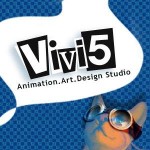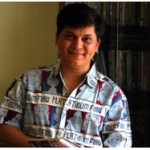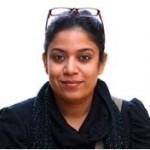 Vivi5* is an animation, art & design collective, spearheaded by Rita Dhankani and Mehul Mahicha. Both being National Institute of Design (NID) alumni and with their respective backgrounds in Applied Arts and Painting, bring in an array of styles under one roof where they create animation and design for design agencies, production houses and corporates.
Vivi5* is an animation, art & design collective, spearheaded by Rita Dhankani and Mehul Mahicha. Both being National Institute of Design (NID) alumni and with their respective backgrounds in Applied Arts and Painting, bring in an array of styles under one roof where they create animation and design for design agencies, production houses and corporates.
AnimationXpress.com caught up with Rita and Mehul to know more about the interesting aspects of their film and they start the conversation with us by saying, “After working in Dubai and then Delhi, with this year we are venturing into yet another planetary, as our headquarter shifts to the city of Bangalore. And we are truly delighted to bring this news on a remarkable platform such as AnimationXpress.com. Presently, we are working on interesting and again variety of projects coming from agencies both in India and abroad.”
 Great to know about your studio allocation to a new place, So, Rita, tell us about the principles that drive VIVI5*?
Great to know about your studio allocation to a new place, So, Rita, tell us about the principles that drive VIVI5*?
Vivi5* is a space where art, design, animation and film blend in to produce communications to enliven sensory senses for our audiences. And our collective name comes from the word ‘Vivify’ which as a single word defines us. *Meaning: to bring life to, to enliven, and to impart vitality.
We strongly believed, ‘a good design’ comes as a wholesome solution to a requirement and cannot be confined to any specific medium or style. This very approach to designing has allowed us to easily adapt to ‘a variety of techniques’ like live-action, animation, illustration, photography, mix medias etc.; for ‘a variety of platforms’ such as Film & Video, Broadcast, Digital, Print, etc., in a short span of over 8 years.
How did this project with UNICEF India happen & what was the brief given to you?
Our association with UNICEF started when Mehul first created an illustration book on ‘Convention on the Rights of the Child’ for national office in 2009. His work and approach got him recognized in UNICEF. What followed were projects such as ‘Millennium Development Goals’ created by both of us while ‘Rights to Education’ illustrated book created by me. These were again truly appreciated not only by UNICEF but also their patrons and associates.
These were illustration oriented and our inclination was to eventually create animation films for UNICEF. We kept sharing ideas of taking ‘Rights to Education Campaign’ further and creating films on the topic with Sohini Roy Chowdhary who was Communication Officer with UNICEF Delhi. It was when Sohini moved to UNICEF Kolkata, and asked us to develop ideas for RTE films. These were to be especially for West Bengal. Brief to our delight was now more specific and required to be rich in its regional look and had to speak to the locals in their accent, in Bangla.
Mehul, please take us down through the approaches that you decided to follow for creating the films?
We all were sure that we wanted two lead characters a girl and a boy who would speak about ‘Child Rights’ in a series of films for UNICEF. And to start with Sohini wanted us to create two films on education. Very first and foremost being ‘what exactly RTE act is?’ and second being ‘what is an ideal school’. She gave us a detail brief on the subject and what message she would like to give in each of the films.
Required duration of the TVC films was 30 seconds for each topic. Although we additionally created 40+ seconds versions for each topic, narrowing down all the factual information into such short duration worked both as a challenge as well guiding line to building our concepts.
Our target audiences were children and it was crucial that we communicate the act to them in a manner they can easily grasp without making it sounding preachy or demanding or of all something alien to them. So we presented it to them as ‘their very own’, which made them feel responsible and find themselves as rightful aspirants of the act by law.
Further, for them to savor the fruits of the act, our films also had to speak to the facilitators of the idea who were adults working in education sectors, parents and people like us. Hence our aim while creating a storyline was to ‘keep it very simple’ so as to make it appealing for all age groups, with children holding the center stage.
Rita, can you give us a much deeper insight into the concepts and storyline creating stage?
For ‘What is Right to Education’ film, Mehul wanted to keep the last frame of the film as the cover page from our RTE illustrated book. This worked perfectly and I created a storyline with a poetry like feel where children from all local regions within West Bengal will come together and narrate one-one line to the audiences, with pride, joy, fun and in festive mood; as they will be seen celebrating their very own right! Parallel-y, we see them working on something which they finally reveal at the end of the film.
For the second film ‘what is an ideal school’, we thought is best to show our lead characters take the audiences around the school with an ‘Ideal School Checklist’ in their hands. And we get to know what facilities make a school an ideal school according to RTE act while as the same time our lead characters conclude theirs is indeed an ideal school!
Both concepts worked well with UNICEF and we got an instant go ahead to write detailed scripts and storyboarding.
After some rounds of fine-tuning, we locked on the scripts. Now it was time to get a translator who well understood Bangla culture. Sohini got Pratya Mitra on board who helps us to translate perfectly. What followed is Animatics with scratch VO. This stage helped us all to narrow down the films even further, making it more precise and to the point.
Mehul, we would also like to know about the research that you all went through and design development phase?
Basically we started with a through research on West Bengal. Other then the information provided by UNICEF; we tried to absorb its culture, music, art, textile, people, language and everything that gives West Bengal its identity and created treatments based on this research to propose the kind of ‘look & feel’ we wanted for this films.
 Next step was to design characters and sets. West Bengal in itself has vivid cultures, from developed cities such as Kolkata to not so developed Purulia, Malda, Bankura etc. And our films were to reach out to smaller regions as these are were target areas. To create our characters coming from these regions, we studied their distinguishing features, clothes, living styles, houses and everything that could help us get a clear idea to recreate in an animation medium.
Next step was to design characters and sets. West Bengal in itself has vivid cultures, from developed cities such as Kolkata to not so developed Purulia, Malda, Bankura etc. And our films were to reach out to smaller regions as these are were target areas. To create our characters coming from these regions, we studied their distinguishing features, clothes, living styles, houses and everything that could help us get a clear idea to recreate in an animation medium.
For their features, Rita looked at Durga statues as inspiration especially her eyes and face cut as it defines beauty and simplicity to its best, and this lead to the creation of Amu in clay to get an idea of the character in three-dimensional form, which was to be later used for all characters in the films.
(Amu, taking form in clay)
Let us know about your selection of animation medium for the subject?
“Once the concepts and scripts were in place, we had to take a call on the medium we choose for making these films. Sohini valued our design and art aesthetics, trusting us completely on the visualization. So fortunately we were in a position almost any animation film-maker would dream off especially while working on a commission work; i.e., flexibility to choose a medium! While so, we also had responsibility of delivering a good quality of films”, says Rita.
Mehul continues, “Stop motion was our first choice as we had seen results while working on ‘Education is my Right’ illustration book project. But since we were thinking of a series of films for RTE, it was obvious we choose a medium that allows easy re-production down the line. Hence we chose 3D animation.”
Rita adds, “At the same time we never gave up on clay. Our target was to create clay-like characters using 3D as our animation medium. Next step was creation of character designs and background design for the 3D modelers as an artwork to follow.”

 Rita, tell how was the audio created for these films?
Rita, tell how was the audio created for these films?
Like we said, the films meant to be specifically for West Bengal. So final voices surely required to be purely in their accent & dialect in Bangla for the locals to relate to characters. Hence voice recording was done in Kolkata where with help of Tanusree B from Rim Communications, we found some lovely children who gave voice for our characters. Back on Delhi, Roy Menezes took care of sound design and created unique music pieces that worked nicely for each film.
Mehul would you like to tell us more about your production team and how much time did it take to complete these films?
We have some amazing people working with us to create films for RTE. Mohammad Shakeel from Animon studio took care of character and set modeling with Puneet and Gaurav Sharma.
While some of our characters were beautifully modeled by Jitendra Sharma and Sameer Ahmed; Sachin Galoria and Teekesh Kumawat worked on animation. Vaibhav Dheer got his expertise in compositing and rendering. Ishan Sharma and Piyush Sharma were our technical consultants.
Like you know these were two films and we were working on each simultaneously, it took a month long for preproduction and two for production.
 (Film Stills: What is Right to Education?)
(Film Stills: What is Right to Education?)
 (Film Stills: What is an Ideal School?)
(Film Stills: What is an Ideal School?)
Are we going to see more of RTE films in future?
Yes of course! There are many more issues that need to be addressed and UNICEF plans to continue using our characters to bring awareness to other child rights. We are currently working on creating films for couple of other subjects, which are next major ones concerning children in West Bengal.








